Kun Zhou
Vision-G1: Towards General Vision Language Reasoning with Multi-Domain Data Curation
Aug 18, 2025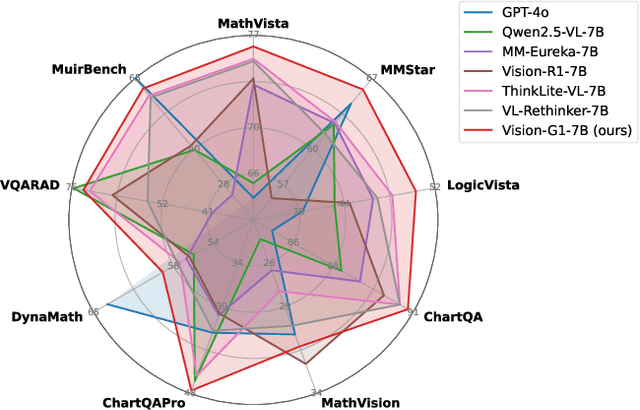
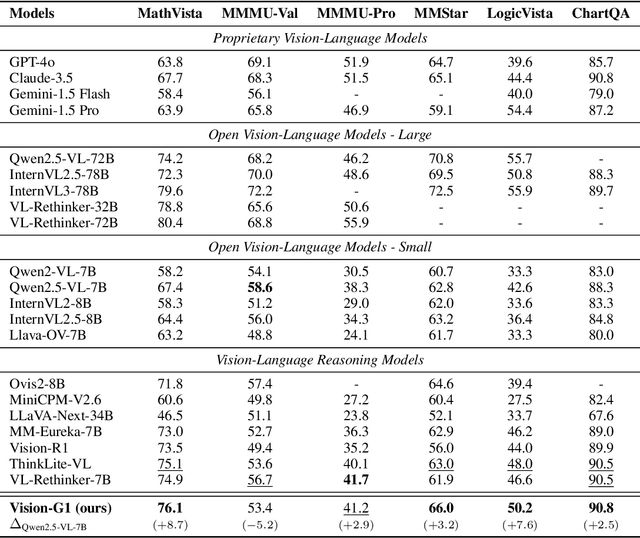

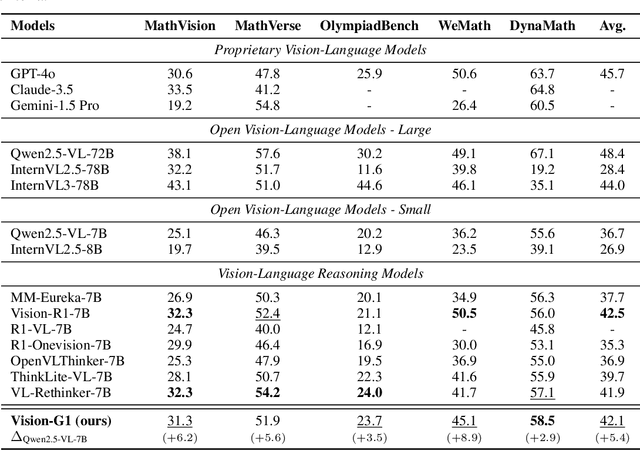
Abstract:Despite their success, current training pipelines for reasoning VLMs focus on a limited range of tasks, such as mathematical and logical reasoning. As a result, these models face difficulties in generalizing their reasoning capabilities to a wide range of domains, primarily due to the scarcity of readily available and verifiable reward data beyond these narrowly defined areas. Moreover, integrating data from multiple domains is challenging, as the compatibility between domain-specific datasets remains uncertain. To address these limitations, we build a comprehensive RL-ready visual reasoning dataset from 46 data sources across 8 dimensions, covering a wide range of tasks such as infographic, mathematical, spatial, cross-image, graphic user interface, medical, common sense and general science. We propose an influence function based data selection and difficulty based filtering strategy to identify high-quality training samples from this dataset. Subsequently, we train the VLM, referred to as Vision-G1, using multi-round RL with a data curriculum to iteratively improve its visual reasoning capabilities. Our model achieves state-of-the-art performance across various visual reasoning benchmarks, outperforming similar-sized VLMs and even proprietary models like GPT-4o and Gemini-1.5 Flash. The model, code and dataset are publicly available at https://github.com/yuh-zha/Vision-G1.
Can Large Pretrained Depth Estimation Models Help With Image Dehazing?
Aug 01, 2025Abstract:Image dehazing remains a challenging problem due to the spatially varying nature of haze in real-world scenes. While existing methods have demonstrated the promise of large-scale pretrained models for image dehazing, their architecture-specific designs hinder adaptability across diverse scenarios with different accuracy and efficiency requirements. In this work, we systematically investigate the generalization capability of pretrained depth representations-learned from millions of diverse images-for image dehazing. Our empirical analysis reveals that the learned deep depth features maintain remarkable consistency across varying haze levels. Building on this insight, we propose a plug-and-play RGB-D fusion module that seamlessly integrates with diverse dehazing architectures. Extensive experiments across multiple benchmarks validate both the effectiveness and broad applicability of our approach.
Motion-example-controlled Co-speech Gesture Generation Leveraging Large Language Models
Jul 27, 2025Abstract:The automatic generation of controllable co-speech gestures has recently gained growing attention. While existing systems typically achieve gesture control through predefined categorical labels or implicit pseudo-labels derived from motion examples, these approaches often compromise the rich details present in the original motion examples. We present MECo, a framework for motion-example-controlled co-speech gesture generation by leveraging large language models (LLMs). Our method capitalizes on LLMs' comprehension capabilities through fine-tuning to simultaneously interpret speech audio and motion examples, enabling the synthesis of gestures that preserve example-specific characteristics while maintaining speech congruence. Departing from conventional pseudo-labeling paradigms, we position motion examples as explicit query contexts within the prompt structure to guide gesture generation. Experimental results demonstrate state-of-the-art performance across three metrics: Fr\'echet Gesture Distance (FGD), motion diversity, and example-gesture similarity. Furthermore, our framework enables granular control of individual body parts and accommodates diverse input modalities including motion clips, static poses, human video sequences, and textual descriptions. Our code, pre-trained models, and videos are available at https://robinwitch.github.io/MECo-Page.
Revisiting Reinforcement Learning for LLM Reasoning from A Cross-Domain Perspective
Jun 17, 2025Abstract:Reinforcement learning (RL) has emerged as a promising approach to improve large language model (LLM) reasoning, yet most open efforts focus narrowly on math and code, limiting our understanding of its broader applicability to general reasoning. A key challenge lies in the lack of reliable, scalable RL reward signals across diverse reasoning domains. We introduce Guru, a curated RL reasoning corpus of 92K verifiable examples spanning six reasoning domains--Math, Code, Science, Logic, Simulation, and Tabular--each built through domain-specific reward design, deduplication, and filtering to ensure reliability and effectiveness for RL training. Based on Guru, we systematically revisit established findings in RL for LLM reasoning and observe significant variation across domains. For example, while prior work suggests that RL primarily elicits existing knowledge from pretrained models, our results reveal a more nuanced pattern: domains frequently seen during pretraining (Math, Code, Science) easily benefit from cross-domain RL training, while domains with limited pretraining exposure (Logic, Simulation, and Tabular) require in-domain training to achieve meaningful performance gains, suggesting that RL is likely to facilitate genuine skill acquisition. Finally, we present Guru-7B and Guru-32B, two models that achieve state-of-the-art performance among open models RL-trained with publicly available data, outperforming best baselines by 7.9% and 6.7% on our 17-task evaluation suite across six reasoning domains. We also show that our models effectively improve the Pass@k performance of their base models, particularly on complex tasks less likely to appear in pretraining data. We release data, models, training and evaluation code to facilitate general-purpose reasoning at: https://github.com/LLM360/Reasoning360
AttentionDrag: Exploiting Latent Correlation Knowledge in Pre-trained Diffusion Models for Image Editing
Jun 16, 2025Abstract:Traditional point-based image editing methods rely on iterative latent optimization or geometric transformations, which are either inefficient in their processing or fail to capture the semantic relationships within the image. These methods often overlook the powerful yet underutilized image editing capabilities inherent in pre-trained diffusion models. In this work, we propose a novel one-step point-based image editing method, named AttentionDrag, which leverages the inherent latent knowledge and feature correlations within pre-trained diffusion models for image editing tasks. This framework enables semantic consistency and high-quality manipulation without the need for extensive re-optimization or retraining. Specifically, we reutilize the latent correlations knowledge learned by the self-attention mechanism in the U-Net module during the DDIM inversion process to automatically identify and adjust relevant image regions, ensuring semantic validity and consistency. Additionally, AttentionDrag adaptively generates masks to guide the editing process, enabling precise and context-aware modifications with friendly interaction. Our results demonstrate a performance that surpasses most state-of-the-art methods with significantly faster speeds, showing a more efficient and semantically coherent solution for point-based image editing tasks.
Plug-and-Play Co-Occurring Face Attention for Robust Audio-Visual Speaker Extraction
May 27, 2025Abstract:Audio-visual speaker extraction isolates a target speaker's speech from a mixture speech signal conditioned on a visual cue, typically using the target speaker's face recording. However, in real-world scenarios, other co-occurring faces are often present on-screen, providing valuable speaker activity cues in the scene. In this work, we introduce a plug-and-play inter-speaker attention module to process these flexible numbers of co-occurring faces, allowing for more accurate speaker extraction in complex multi-person environments. We integrate our module into two prominent models: the AV-DPRNN and the state-of-the-art AV-TFGridNet. Extensive experiments on diverse datasets, including the highly overlapped VoxCeleb2 and sparsely overlapped MISP, demonstrate that our approach consistently outperforms baselines. Furthermore, cross-dataset evaluations on LRS2 and LRS3 confirm the robustness and generalizability of our method.
Activation Control for Efficiently Eliciting Long Chain-of-thought Ability of Language Models
May 23, 2025Abstract:Despite the remarkable reasoning performance, eliciting the long chain-of-thought (CoT) ability in large language models (LLMs) typically requires costly reinforcement learning or supervised fine-tuning on high-quality distilled data. We investigate the internal mechanisms behind this capability and show that a small set of high-impact activations in the last few layers largely governs long-form reasoning attributes, such as output length and self-reflection. By simply amplifying these activations and inserting "wait" tokens, we can invoke the long CoT ability without any training, resulting in significantly increased self-reflection rates and accuracy. Moreover, we find that the activation dynamics follow predictable trajectories, with a sharp rise after special tokens and a subsequent exponential decay. Building on these insights, we introduce a general training-free activation control technique. It leverages a few contrastive examples to identify key activations, and employs simple analytic functions to modulate their values at inference time to elicit long CoTs. Extensive experiments confirm the effectiveness of our method in efficiently eliciting long CoT reasoning in LLMs and improving their performance. Additionally, we propose a parameter-efficient fine-tuning method that trains only a last-layer activation amplification module and a few LoRA layers, outperforming full LoRA fine-tuning on reasoning benchmarks with significantly fewer parameters. Our code and data are publicly released.
Towards General Continuous Memory for Vision-Language Models
May 23, 2025



Abstract:Language models (LMs) and their extension, vision-language models (VLMs), have achieved remarkable performance across various tasks. However, they still struggle with complex reasoning tasks that require multimodal or multilingual real-world knowledge. To support such capabilities, an external memory system that can efficiently provide relevant multimodal information is essential. Existing approaches generally concatenate image and text tokens into a long sequence as memory, which, however, may drastically increase context length and even degrade performance. In contrast, we propose using continuous memory, a compact set of dense embeddings to more effectively and efficiently represent multimodal and multilingual knowledge. Our key insight is that a VLM can serve as its own continuous memory encoder. We empirically show that this design improves performance on complex multimodal reasoning tasks. Building on this, we introduce a data-efficient and parameter-efficient method to fine-tune the VLM into a memory encoder, requiring only 1.2% of the model's parameters and a small corpus of 15.6K self-synthesized samples. Our approach CoMEM utilizes VLM's original capabilities to encode arbitrary multimodal and multilingual knowledge into just 8 continuous embeddings. Since the inference-time VLM remains frozen, our memory module is plug-and-play and can be flexibly integrated as needed. Extensive experiments across eight multimodal reasoning benchmarks demonstrate the effectiveness of our approach.
Decentralized Arena: Towards Democratic and Scalable Automatic Evaluation of Language Models
May 19, 2025



Abstract:The recent explosion of large language models (LLMs), each with its own general or specialized strengths, makes scalable, reliable benchmarking more urgent than ever. Standard practices nowadays face fundamental trade-offs: closed-ended question-based benchmarks (eg MMLU) struggle with saturation as newer models emerge, while crowd-sourced leaderboards (eg Chatbot Arena) rely on costly and slow human judges. Recently, automated methods (eg LLM-as-a-judge) shed light on the scalability, but risk bias by relying on one or a few "authority" models. To tackle these issues, we propose Decentralized Arena (dearena), a fully automated framework leveraging collective intelligence from all LLMs to evaluate each other. It mitigates single-model judge bias by democratic, pairwise evaluation, and remains efficient at scale through two key components: (1) a coarse-to-fine ranking algorithm for fast incremental insertion of new models with sub-quadratic complexity, and (2) an automatic question selection strategy for the construction of new evaluation dimensions. Across extensive experiments across 66 LLMs, dearena attains up to 97% correlation with human judgements, while significantly reducing the cost. Our code and data will be publicly released on https://github.com/maitrix-org/de-arena.
A 2D Semantic-Aware Position Encoding for Vision Transformers
May 14, 2025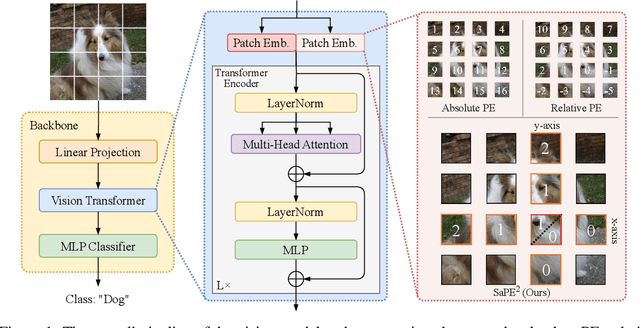
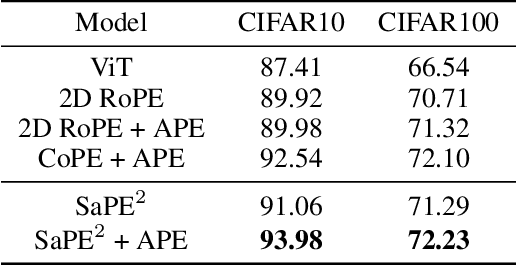
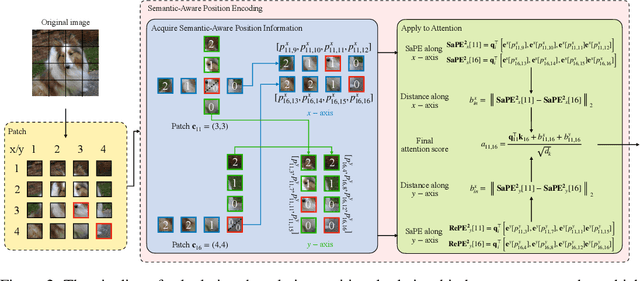
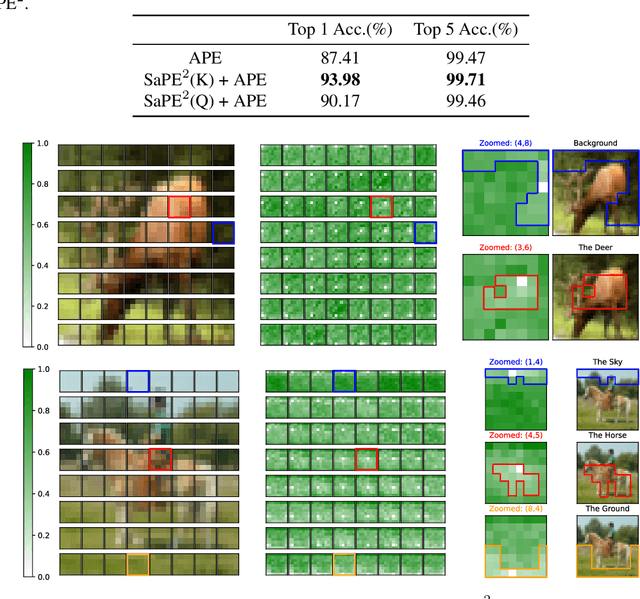
Abstract:Vision transformers have demonstrated significant advantages in computer vision tasks due to their ability to capture long-range dependencies and contextual relationships through self-attention. However, existing position encoding techniques, which are largely borrowed from natural language processing, fail to effectively capture semantic-aware positional relationships between image patches. Traditional approaches like absolute position encoding and relative position encoding primarily focus on 1D linear position relationship, often neglecting the semantic similarity between distant yet contextually related patches. These limitations hinder model generalization, translation equivariance, and the ability to effectively handle repetitive or structured patterns in images. In this paper, we propose 2-Dimensional Semantic-Aware Position Encoding ($\text{SaPE}^2$), a novel position encoding method with semantic awareness that dynamically adapts position representations by leveraging local content instead of fixed linear position relationship or spatial coordinates. Our method enhances the model's ability to generalize across varying image resolutions and scales, improves translation equivariance, and better aggregates features for visually similar but spatially distant patches. By integrating $\text{SaPE}^2$ into vision transformers, we bridge the gap between position encoding and perceptual similarity, thereby improving performance on computer vision tasks.
 Add to Chrome
Add to Chrome Add to Firefox
Add to Firefox Add to Edge
Add to Edge